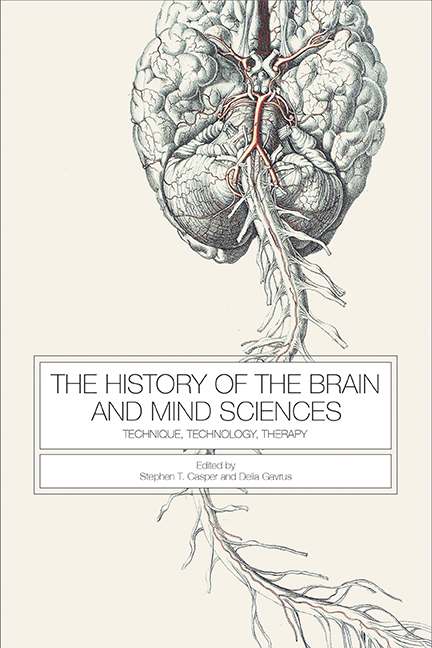Book contents
- Frontmatter
- Contents
- Acknowledgments
- Introduction
- 1 “We Are Veritable Animals”: The Nineteenth-Century Paris Menagerie as a Site for the Science of Intelligence
- 2 “Physiological Surgery”: Laboratory Science as the Epistemic Basis of Modern Surgery (and Neurosurgery)
- 3 Configuring Epidemic Encephalitis as a National and International Neurological Concern
- 4 Circuits, Algae, and Whipped Cream: The Biophysics of Nerve, ca. 1930
- 5 Epilepsy and the Laboratory Technician: Technique in Histology and Fiction
- 6 “What Was in Their Luggage?”: German Refugee Neuroscientists, Migrating Technologies, and the Emergence of Interdisciplinary Research Networks in North America, 1933 to 1963
- 7 Dualist Techniques for Materialist Imaginaries: Matter and Mind in the 1951 Festival of Britain
- 8 A “Model Schizophrenia”: Amphetamine Psychosis and the Transformation of American Psychiatry
- 9 Salvation through Reductionism: The National Institute of Mental Health and the Return to Biological Psychiatry
- Coda: Technique, Marginality, and History
- Bibliography
- List of Contributors
- Index
8 - A “Model Schizophrenia”: Amphetamine Psychosis and the Transformation of American Psychiatry
Published online by Cambridge University Press: 26 May 2021
- Frontmatter
- Contents
- Acknowledgments
- Introduction
- 1 “We Are Veritable Animals”: The Nineteenth-Century Paris Menagerie as a Site for the Science of Intelligence
- 2 “Physiological Surgery”: Laboratory Science as the Epistemic Basis of Modern Surgery (and Neurosurgery)
- 3 Configuring Epidemic Encephalitis as a National and International Neurological Concern
- 4 Circuits, Algae, and Whipped Cream: The Biophysics of Nerve, ca. 1930
- 5 Epilepsy and the Laboratory Technician: Technique in Histology and Fiction
- 6 “What Was in Their Luggage?”: German Refugee Neuroscientists, Migrating Technologies, and the Emergence of Interdisciplinary Research Networks in North America, 1933 to 1963
- 7 Dualist Techniques for Materialist Imaginaries: Matter and Mind in the 1951 Festival of Britain
- 8 A “Model Schizophrenia”: Amphetamine Psychosis and the Transformation of American Psychiatry
- 9 Salvation through Reductionism: The National Institute of Mental Health and the Return to Biological Psychiatry
- Coda: Technique, Marginality, and History
- Bibliography
- List of Contributors
- Index
Summary
Introduction
During the early 1950s, dozens of individuals began to show up at London area hospitals with delusions of persecution. Some of them had auditory hallucinations that bolstered their delusional ideas. Clinicians promptly diagnosed them with paranoid schizophrenia and admitted them on an in-patient basis. Within days, their symptoms cleared up and they were discharged.
Further examination revealed that the ingestion of large amounts of amphetamines (or the habitual use of amphetamines over a prolonged period of time) precipitated these individuals’ psychotic episodes. In 1953 a medical student at the University of London, P. H. Connell, studied several patients and coined the term amphetamine psychosis for this rather infrequent but disturbing effect of amphetamine use. In 1958 he published a short, influential monograph with that title. Connell was not primarily interested in the phenomenon from a biochemical perspective. Rather, he was interested in amphetamine psychosis from a clinical perspective, and also from the perspective of a public health advocate. In coining the term, he was not merely giving clinicians a valuable technique for making a differential diagnosis; he was also framing recreational amphetamine use as a kind of silent epidemic or public health nuisance.
While Connell warned the medical profession about the dangers of amphetamine use, biochemical researchers extracted a very different lesson from his monograph. Could amphetamine psychosis be used as a biochemical model of schizophrenia? That is, by studying the mode of action of amphetamines on the brain, could one discover the biochemical basis of schizophrenia itself—and ultimately develop more exacting, pharmacological, treatments? As Solomon Snyder, one of the American architects of the dopamine hypothesis of schizophrenia, later put it, “a drug which could elicit a ‘model schizophrenia’ would be a boon to psychiatry.” To say that it would be a boon to psychiatry was an understatement. Amphetamine psychosis would give researchers a new window into the mechanism of schizophrenia.
Biochemical researchers, however, were slow to adopt the theory that amphetamine psychosis constituted a “model schizophrenia.”
- Type
- Chapter
- Information
- The History of the Brain and Mind SciencesTechnique, Technology, Therapy, pp. 202 - 228Publisher: Boydell & BrewerPrint publication year: 2017



